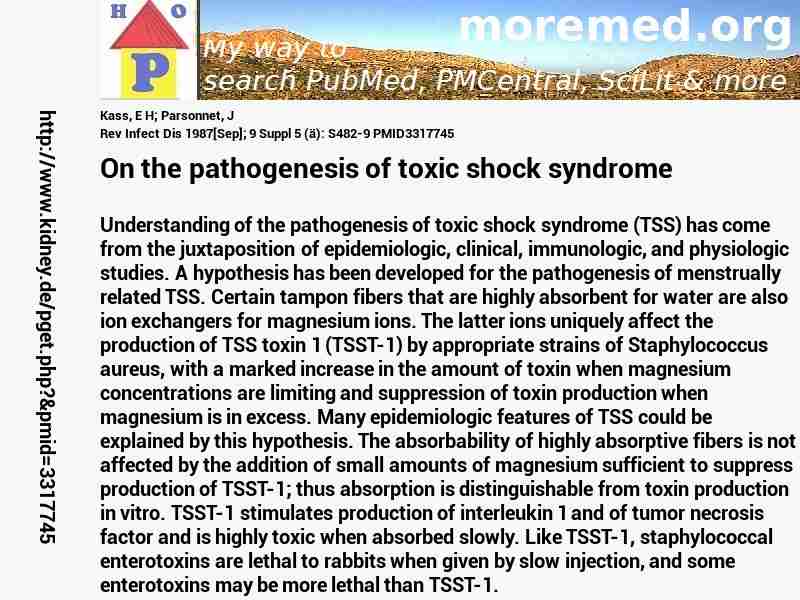
|
10.1093/clinids/9.supplement_5.s482
http://scihub22266oqcxt.onion/10.1093/clinids/9.supplement_5.s482

3317745!�!3317745
|  
Warning: imagejpeg(C:\Inetpub\vhosts\kidney.de\httpdocs\phplern\3317745.jpg): Failed to open stream: No such file or directory in C:\Inetpub\vhosts\kidney.de\httpdocs\pget.php on line 117
 Rev+Infect+Dis 1987 ; 9 Suppl 5 (�): S482-9 Rev+Infect+Dis 1987 ; 9 Suppl 5 (�): S482-9
Nephropedia Template TP
gab.com Text
Twit Text FOAVip
Twit Text #
English Wikipedia
|
On the pathogenesis of toxic shock syndrome #MMPMID3317745Kass EH; Parsonnet JRev Infect Dis 1987[Sep]; 9 Suppl 5 (�): S482-9 PMID3317745show ga
Understanding of the pathogenesis of toxic shock syndrome (TSS) has come from the juxtaposition of epidemiologic, clinical, immunologic, and physiologic studies. A hypothesis has been developed for the pathogenesis of menstrually related TSS. Certain tampon fibers that are highly absorbent for water are also ion exchangers for magnesium ions. The latter ions uniquely affect the production of TSS toxin 1 (TSST-1) by appropriate strains of Staphylococcus aureus, with a marked increase in the amount of toxin when magnesium concentrations are limiting and suppression of toxin production when magnesium is in excess. Many epidemiologic features of TSS could be explained by this hypothesis. The absorbability of highly absorptive fibers is not affected by the addition of small amounts of magnesium sufficient to suppress production of TSST-1; thus absorption is distinguishable from toxin production in vitro. TSST-1 stimulates production of interleukin 1 and of tumor necrosis factor and is highly toxic when absorbed slowly. Like TSST-1, staphylococcal enterotoxins are lethal to rabbits when given by slow injection, and some enterotoxins may be more lethal than TSST-1.|*Bacterial Toxins[MESH]|*Superantigens[MESH]|Enterotoxins/*biosynthesis[MESH]|Female[MESH]|Humans[MESH]|Magnesium/*metabolism[MESH]|Menstrual Hygiene Products/*adverse effects[MESH]|Menstruation[MESH]|Shock, Septic/*etiology[MESH]
  
DeepDyve
Pubget Overpricing | 
|